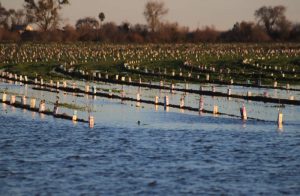 Promoting floodplains as a way to refill aquifers, reduce risk from flood damage, re-create wildlife habitat and filter pollutants.
Promoting floodplains as a way to refill aquifers, reduce risk from flood damage, re-create wildlife habitat and filter pollutants.
From KQED Science – When a wild river floods, water and sediment spills over its banks onto adjacent land, it builds up a natural floodplain. Floodplains allow a river’s high flows to spread out and slow down, forming temporary reservoirs that pool over the rainy season. That means more water percolating down into underlying aquifers — a layer of permeable rock, sand, gravel and silt that stores water — and less floodwaters barreling toward cities. Low points on a floodplain, or swales, also serve as food chambers for fish. For much of the last century, standard practice in California has been to channelize rivers, choking off high flows from their natural floodplains, in an effort to protect crops and cities. But that convention is evolving. In his state-of-the state address this February, Governor Gavin Newsom vowed to expand floodplain habitat in the Central Valley. This is one approach California is investing in to increase groundwater storage and reduce flood damage. (more)

